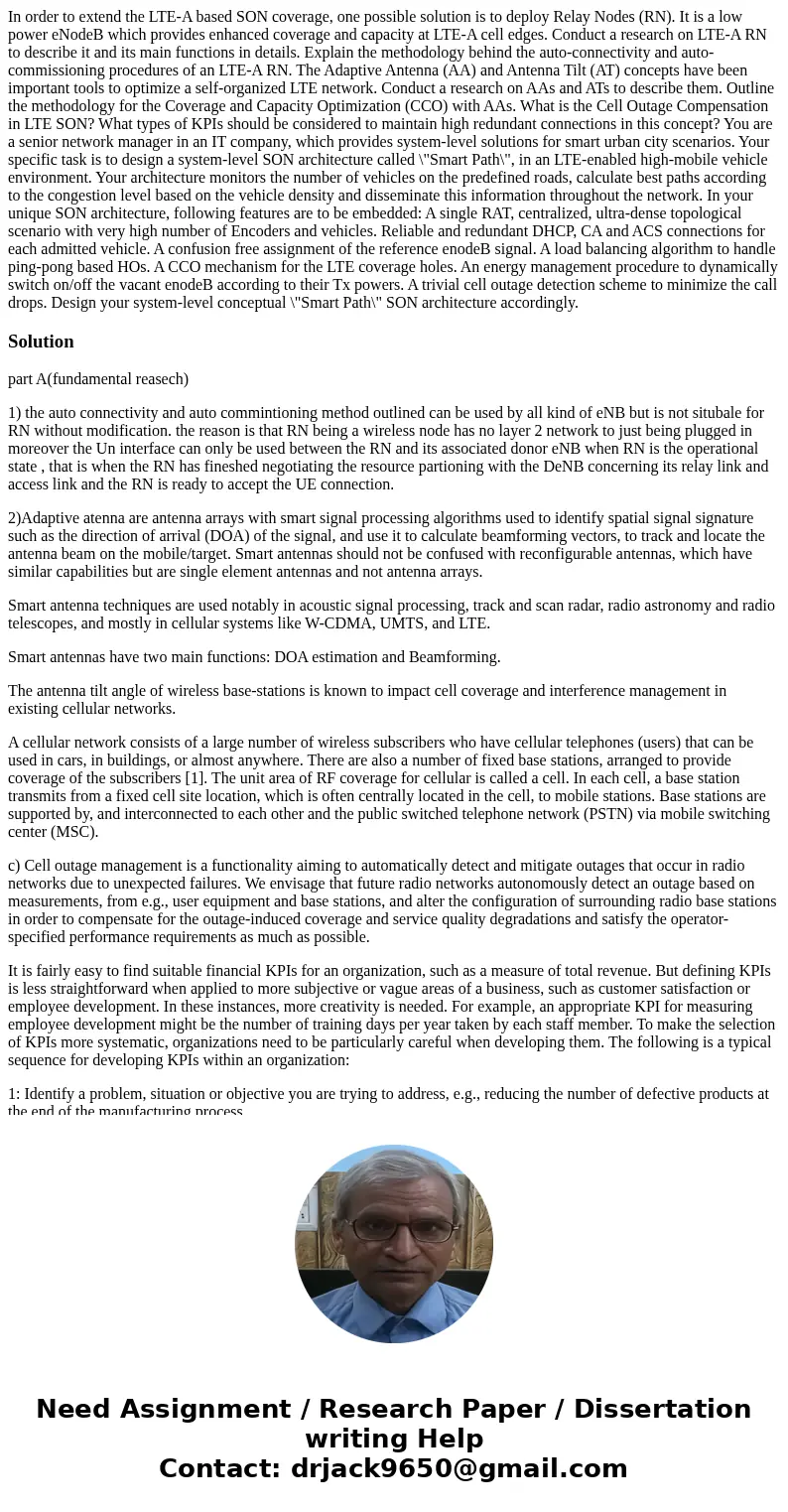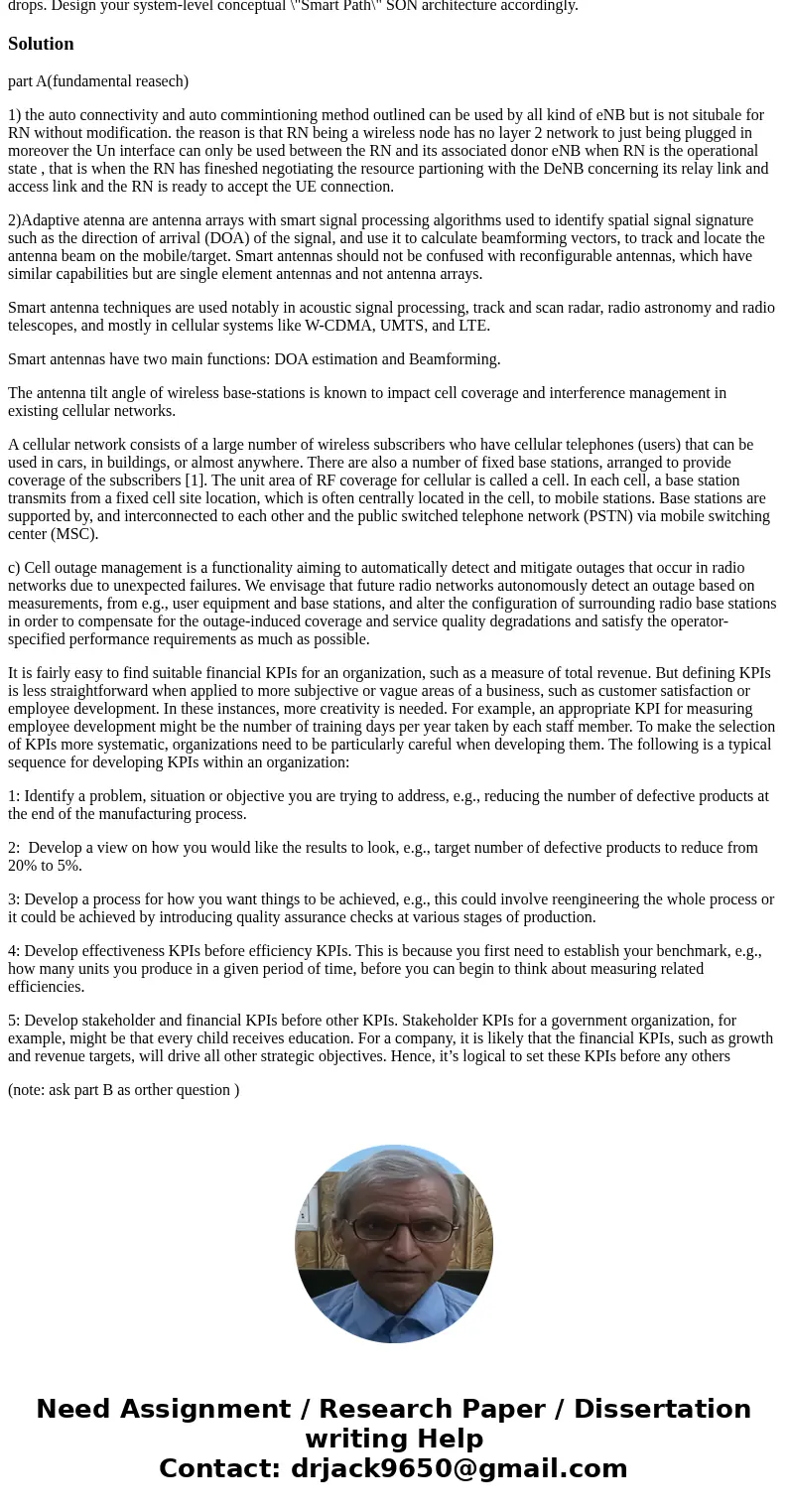In order to extend the LTEA based SON coverage one possible
Solution
part A(fundamental reasech)
1) the auto connectivity and auto commintioning method outlined can be used by all kind of eNB but is not situbale for RN without modification. the reason is that RN being a wireless node has no layer 2 network to just being plugged in moreover the Un interface can only be used between the RN and its associated donor eNB when RN is the operational state , that is when the RN has fineshed negotiating the resource partioning with the DeNB concerning its relay link and access link and the RN is ready to accept the UE connection.
2)Adaptive atenna are antenna arrays with smart signal processing algorithms used to identify spatial signal signature such as the direction of arrival (DOA) of the signal, and use it to calculate beamforming vectors, to track and locate the antenna beam on the mobile/target. Smart antennas should not be confused with reconfigurable antennas, which have similar capabilities but are single element antennas and not antenna arrays.
Smart antenna techniques are used notably in acoustic signal processing, track and scan radar, radio astronomy and radio telescopes, and mostly in cellular systems like W-CDMA, UMTS, and LTE.
Smart antennas have two main functions: DOA estimation and Beamforming.
The antenna tilt angle of wireless base-stations is known to impact cell coverage and interference management in existing cellular networks.
A cellular network consists of a large number of wireless subscribers who have cellular telephones (users) that can be used in cars, in buildings, or almost anywhere. There are also a number of fixed base stations, arranged to provide coverage of the subscribers [1]. The unit area of RF coverage for cellular is called a cell. In each cell, a base station transmits from a fixed cell site location, which is often centrally located in the cell, to mobile stations. Base stations are supported by, and interconnected to each other and the public switched telephone network (PSTN) via mobile switching center (MSC).
c) Cell outage management is a functionality aiming to automatically detect and mitigate outages that occur in radio networks due to unexpected failures. We envisage that future radio networks autonomously detect an outage based on measurements, from e.g., user equipment and base stations, and alter the configuration of surrounding radio base stations in order to compensate for the outage-induced coverage and service quality degradations and satisfy the operator-specified performance requirements as much as possible.
It is fairly easy to find suitable financial KPIs for an organization, such as a measure of total revenue. But defining KPIs is less straightforward when applied to more subjective or vague areas of a business, such as customer satisfaction or employee development. In these instances, more creativity is needed. For example, an appropriate KPI for measuring employee development might be the number of training days per year taken by each staff member. To make the selection of KPIs more systematic, organizations need to be particularly careful when developing them. The following is a typical sequence for developing KPIs within an organization:
1: Identify a problem, situation or objective you are trying to address, e.g., reducing the number of defective products at the end of the manufacturing process.
2: Develop a view on how you would like the results to look, e.g., target number of defective products to reduce from 20% to 5%.
3: Develop a process for how you want things to be achieved, e.g., this could involve reengineering the whole process or it could be achieved by introducing quality assurance checks at various stages of production.
4: Develop effectiveness KPIs before efficiency KPIs. This is because you first need to establish your benchmark, e.g., how many units you produce in a given period of time, before you can begin to think about measuring related efficiencies.
5: Develop stakeholder and financial KPIs before other KPIs. Stakeholder KPIs for a government organization, for example, might be that every child receives education. For a company, it is likely that the financial KPIs, such as growth and revenue targets, will drive all other strategic objectives. Hence, it’s logical to set these KPIs before any others
(note: ask part B as orther question )


 Homework Sourse
Homework Sourse